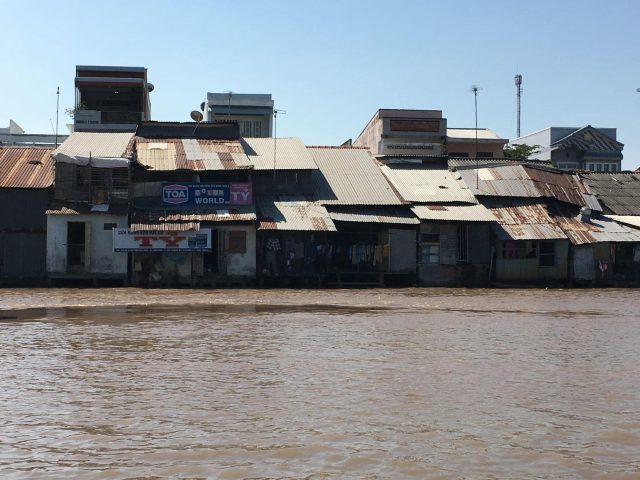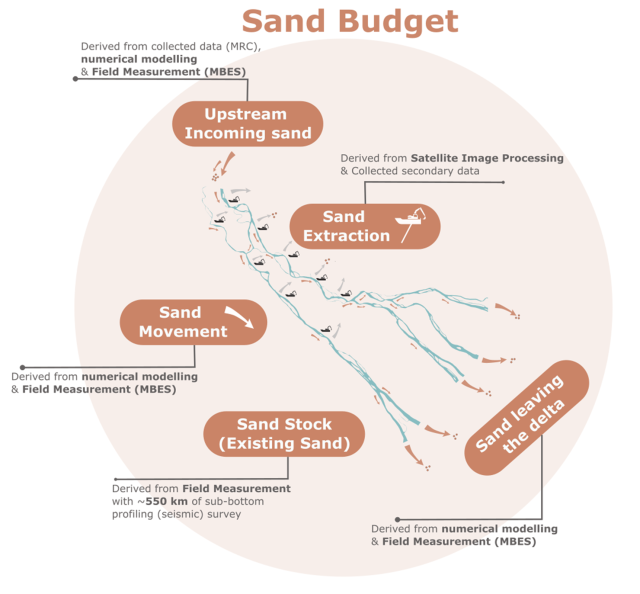Uncovering the Mekong Sand Debt
Until the 1990s, the Mekong river was one of the most pristine in the world. But increased economic activity, including sand extraction, has caused it to become one of the world’s most vulnerable. Research by Deltares experts and local partners has now shown that the Mekong Delta is now in danger of sand debt due to sand mining and upstream impoundments. If existing practices persist, the current sand stock may not last beyond a decade.

The Mekong Delta is the third largest in the world and is a biodiversity hotspot and home to over 21 million people in Vietnam. Its fertile land is crucial for the local, national and regional economy, job and food security. Urbanisation and intense human economic activity has made the Mekong Delta vulnerable to even moderate environmental variabilities.
Researchers from Deltares and Utrecht University in the context of the Rise and Fall research project studied trends of salinisation and subsidence in the Mekong Delta. The study identified, quantified, and linked the existing trends of salinity to riverbed erosion caused by fluvial sediment decline due to upstream dams and downstream sand mining along the Mekong River. Trends of 10-15 cm per year riverbed erosion also drive tidal amplification of approximately 2 cm per year over the past two decades.

The impact of human activity
While salinity in the dry season of the Mekong Delta has been norm for centuries, its frequency and intensity has been increasing significantly with grave consequences for agriculture, freshwater supply, and the livelihood of millions of people. At the same time, while deltas naturally subside as young geological formations, the increasing trends of land subsidence has been alarming, threatening infrastructure and gradually increasing the costs of maintaining status quo.
Researchers at Deltares and Utrecht University have shown that increased salinity is only ~5% associated to relative sea level rise and climate change, but ~5% caused by riverbed erosion and the impact on tides and salinity dynamics, and riverbed erosion is largely driven by human activities of damming and sand mining. Riverbed erosion and decline of fluvial sediment supply is also responsible for frequent riverbank erosion all across the main river branches in and beyond the delta. Similarly, increased land subsidence is also largely driven by groundwater extraction, and a shortage or lack of fluvial sediment replenishment due to upstream dams and downstream diking.
The research results of the work by Deltares and Utrecht University are the first in the world to combine the effects of climate change and human activity at scale of a mega-delta, disentangling the effects of anthropogenic drivers versus climate change. As a result, they were able to determine human economic activity is responsible for 95% of the Mekong’s problems.

The sand debt
The two main human activities are upstream dams, and sand mining. The combination of these two activities mean that sand is being extracted at a quicker rate than it can be replenished, creating sand debt.
Sand mining operations are located along the Mekong River in Cambodia, Laos, and Vietnam. Sand is being mined in vast quantities. Channels are becoming deeper. Official sources say the Mekong Delta is shrinking by 500 hectares each year due to erosion. Deltares researchers have concluded that unless there are changes in supply and demand of sand in the delta, the remaining sand reserves will vanish within the coming decade.
Erosion in the delta is driven by two factors; a shortage of fine sediment due to upstream dams, and a coarse sediment shortage (sand) due to sand mining downstream. These two factors both lead to riverbed, bank, and coastal erosion.

A sand budget for safe and sustainable sand management
Despite the devastating impact the sand debt can have on the region, it is not always immediately visible to local populations and decision-makers, making it easy to fall under the political radar. Furthermore, sand remains a vital natural resource, fuelling Vietnam’s economic growth.
This sand budget is intended to inform local and national authorities, taking into account the different complexities and uncertainties. It equips the decision makers with the necessary information for well-informed decisions in managing the sand resources of the delta.
Together with local partners CEFD (Hanoi University of Science ) and SRHMC, including WWF Viet Nam, Deltares in association with UNESCO-IHE developed a sand budget for the Mekong Delta. To establish a sand budget for the VMD, five factors needed to be determined:
- the sand entering the Mekong Delta;
- sand movement within the delta;
- existing sand stock of the VMD;
- sand extraction from the delta, and;
- sand leaving the delta.
The figure below provides an overview of how different components of the current study contribute to the delta-wide sand budget.


